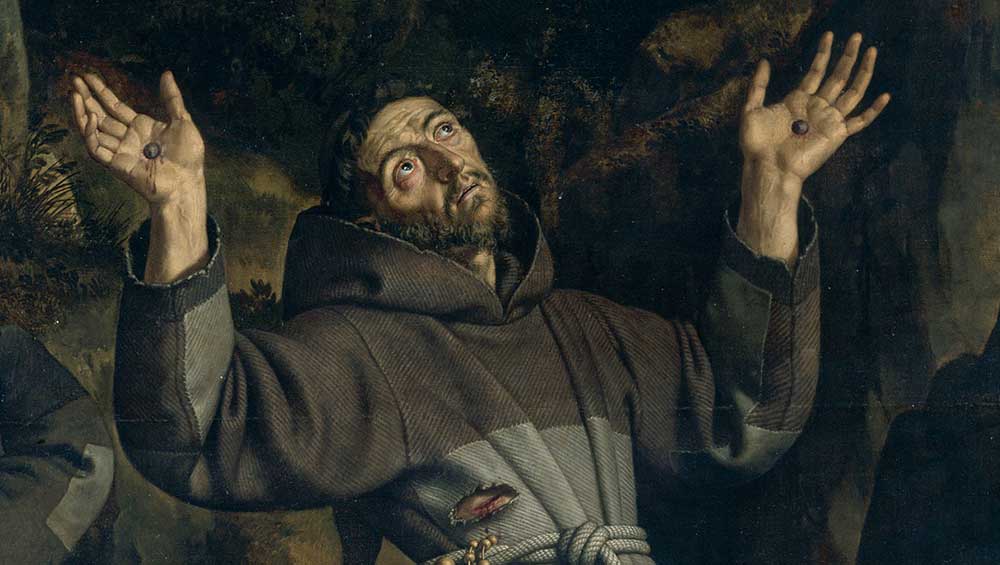
Frans Pourbus the Younger, 1569 – 1622. Saint Francis Receiving the Stigmata, 1620 (detail). Oil on canvas, 227 x 162 cm. Musée du Louvre, Paris. © RMN-Grand Palais (musée du Louvre) / Gérard Blot.
National Gallery, London
6 May – 30 July 2023
by ANNA McNAY
Giovanni di Pietro di Bernardone was born in Assisi in 1181 or 1182, more than a millennium after Jesus, the apostles and the first saints. His father, a wealthy cloth merchant who had much business in France, accordingly nicknamed him “Francis”. Adopting this name, Francis went on not only to become Saint Francis (he was canonised in 1228, two years after his death) and founder of the Franciscan order, but also to be heralded as an alter Christus (“another Christ”), after the five wounds of the stigmata were imprinted on his body in 1224. His conversion to Christianity had come about through a series of events, including renouncing his earthly father (after he was scolded by him for giving away his cloak to a poor knight), living as a penitent, and an encounter with a painting of the crucifix, in the ruined church of St Damiano, outside the walls of Assisi, from which Christ is said to have spoken to him, saying: “Francis, rebuild My house; as you see, it is all being destroyed.” As such, Francis’s story might well be said to have begun with a painting.
As the Franciscan movement grew, the visual arts became increasingly important in the telling of Francis’s story, not least because much art also sits very nicely with the Franciscan ethics of poverty. As the co-curator of the National Gallery’s exhibition, Joost Joustra, says: “Artists, by their very nature, transform the humblest materials into something magnificent.”1 The first visual biography of Francis was made by Giotto and collaborators, in about 1300, in the form of frescoes filling the Upper Church, San Francesco, Assisi, but art historians now estimate that as many as 20,000 images of Francis have been made in the centuries since his death – and this doesn’t include the myriad depictions of him in illuminated manuscripts. The amount of extant material relating to this saint is said to eclipse that of any other. The habits worn by Francis and his followers were patched together from cloth and old clothing donated by the peasants whom they served, who always wore undyed brown, the least expensive material of the time. Additionally, with their pointed hoods, they are cruciform in shape, such that their wearers literally embody Christ. Francis has thus become recognisable throughout art history because of this brown habit, as well, of course, as the marks of the stigmata.
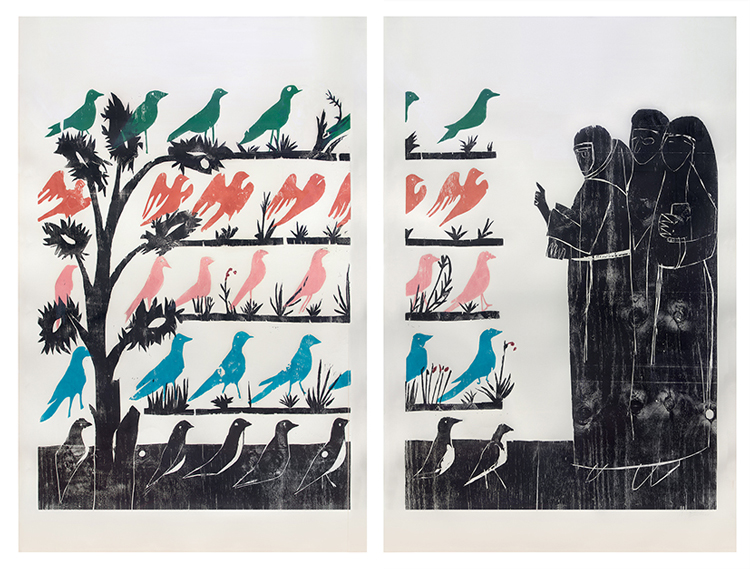
Andrea Büttner. Vogelpredigt (Sermon to the Birds), 2010. Woodcut on paper, 180 x 240 cm. Private collection. © Andrea Büttner. DACS 2023.
This exhibition is a survey of some of the countless works representing or dedicated to this patron saint of animals, birds and the environment. It brings together 800 years of history in seven rooms; from 13th-century panel paintings and manuscripts – a copy of the Assisi Chartula, a mid-14th-century compilation of Franciscan texts, boasts one of only two surviving autographs of the saint – to contemporary artists, including Antony Gormley, Richard Long and Andrea Büttner. As the curators explain, they are seeking to strike a balance between the known and the lesser-known motifs, the serious and the whimsical.
While the frescos of Giotto could not be transported for the exhibition, there is an eloquent visual biography of the saint in the form of a series of panels by the early-Renaissance artist known as Sassetta, Scenes from the Life of Saint Francis, made for the Borgo San Sepolcro altarpiece (1437-44). The National Gallery is lucky enough to own seven of the eight narrative scenes, depicting pivotal moments from the life of Francis, beginning with him giving away his cloak. These pivotal moments and meaningful scenes from his thaumaturgical life have, alongside his brown habit and marks of the stigmata, become motifs by which Francis is typically represented.
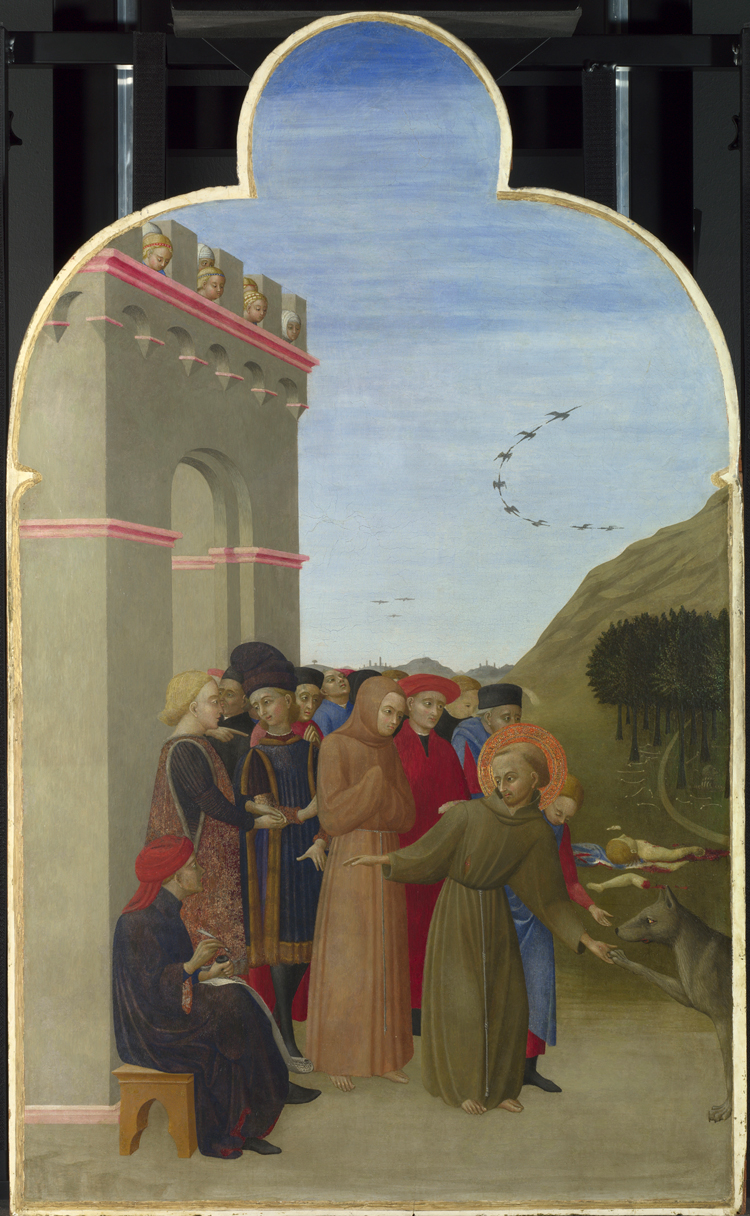
Sassetta. San Sepolcro Altarpiece. The Wolf of Gubbio, 1437-44. Egg tempera on poplar, 87 x 52.4 cm. © The National Gallery, London.
Other such scenes include his encounter with the wolf of Gubbio (compare the depictions by Sassetta and Luc-Olivier Merson); his meeting with a Muslim sultan while travelling with crusaders, and his promise (declined by the sultan, for fear of a popular uprising against him) to walk through fire to prove his faith; and his preaching to the birds – symbolic of his preaching to everyone – which is popular especially in English tradition. This latter motif is represented in the exhibition by Stanley Spencer’s Saint Francis and the Birds (1935), for which the artist reimagined his father in a dressing gown feeding the chickens. As he told the compiler of a Tate catalogue in the 1950s: “The figure of Saint Francis is large and spreading to signify that the teaching of Saint Francis spreads far and wide.”2
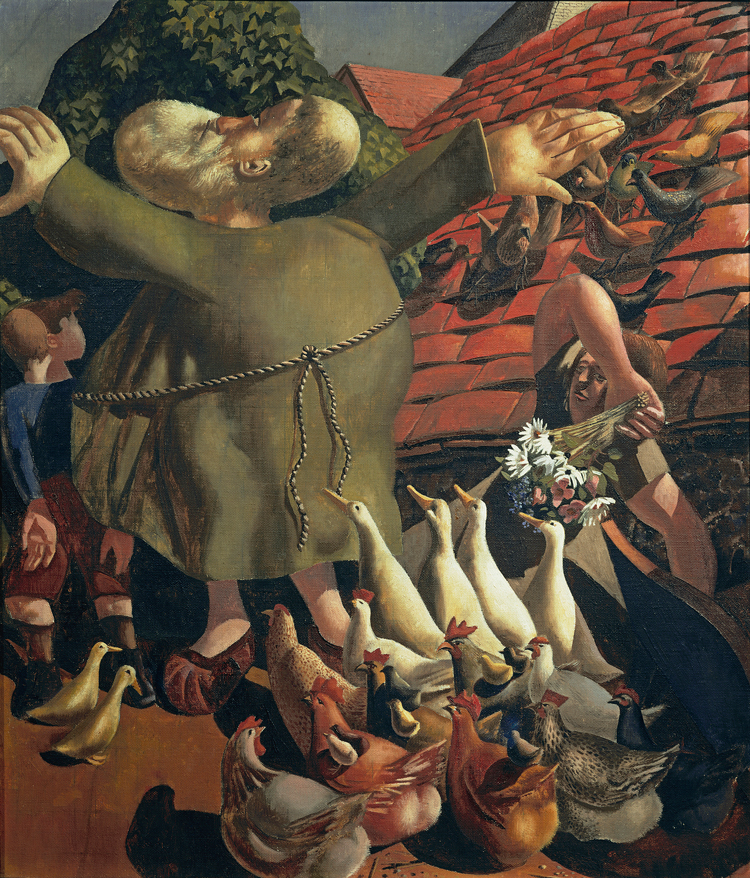
Stanley Spencer. St Francis and the Birds, 1935. Oil on canvas, 71.3 x 61.2 cm. Tate, London. © Estate of Stanley Spencer. All rights reserved 2023 / Bridgeman Images / photo: Tate.
A contemporary depiction of this scene is the woodcut diptych by Büttner – Vogelpredigt (Sermon to the Birds) (2010) – simple, graphic and modern, while clearly making reference to the style of medieval religious icons (it is based on a scene from Saint Francis and 20 Stories from his Life (the so-called Bardi Panel), made by the Florentine artist Coppo di Marcovaldo, for the Basilica of Santa Croce in Florence, between 1245 and 1250).
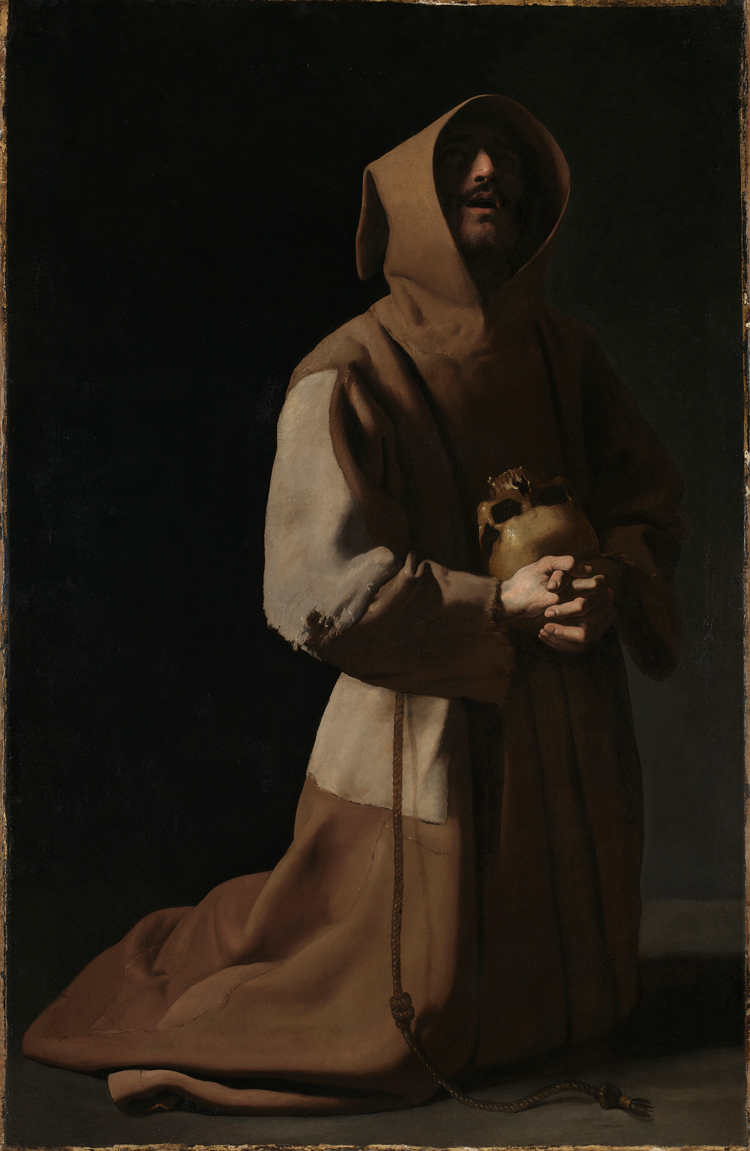
Francisco de Zurbarán. Saint Francis in Meditation, 1635-9. Oil on canvas, 152 x 99 cm. © The National Gallery, London.
The exhibition opens with perhaps the best-known and most-celebrated image of Francis – Francisco de Zurbarán’s Saint Francis in Meditation (1635-39) – which is also owned by the National Gallery. It is at once minutely detailed – the stitches of his patched habit, his mouth agape, the light catching on his rope belt, and the manner in which he is wringing his hands so that his skin looks wrinkled yet taut – and abstracted to its bare essence, with his upturned face hidden within the cavern of his hood, a perfect triangle of light accenting his nose.
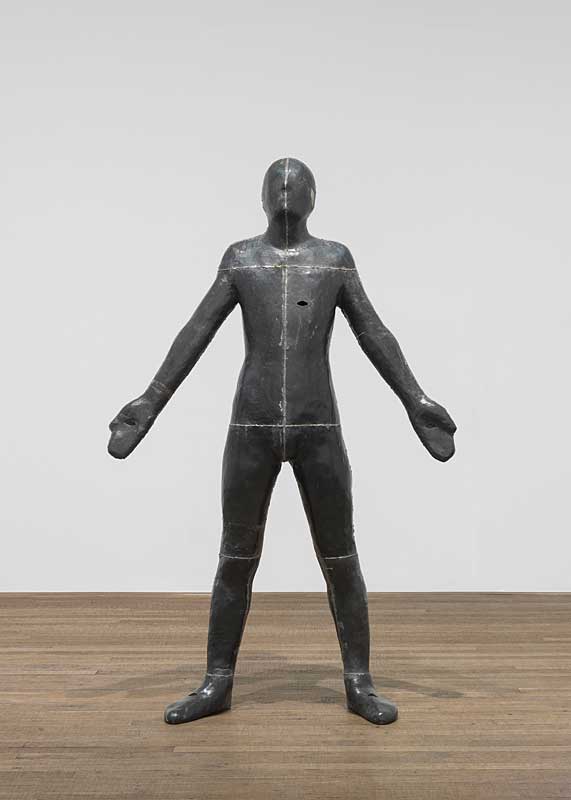
Antony Gormley. Untitled (for Francis), 1985. Lead, fibreglass and plaster, 190 x 117 x 29 cm. Tate, London. © Antony Gormley / photo: Tate.
Abstracted several steps further, the lead body-cast of Gormley’s Untitled (for Francis) (1985) greets visitors as they enter the first gallery. Gormley grew up in a household in which Francis had a strong presence, as his father was inspired by his message of meekness and humility. The cast, pierced with eye-shaped holes to represent the stigmata, which invite you to look within and to embody the sculpture, the saint, stands gazing upwards, in the stance he takes in Giovanni Bellini’s Saint Francis in the Desert (c1475-80) (owned by the Frick Collection, New York, and sadly not in the exhibition), where he is greeting the sun. This is one of many artworks inspired by the Canticle of the Sun, written by Francis in 1224. As the following excerpt illustrates, it is no exaggeration to refer to this as Francis’s own “work of art”, since his descriptions are visual and almost painterly:
Praised be You, my Lord, with all Your creatures,
Especially Sir Brother Sun,
Who is the day and through whom You give us light.
And he is beautiful and radiant with great splendour;
And bears a likeness of You, Most High One.
A work which is on display in the exhibition (on loan from the Castle Howard Collection in north Yorkshire), and which, also drawing from Bellini, depicts this praising of Brother Sun, is Giovanni Costa’s Brother Francis and Brother Sun (Frate Francesco e Frate Sole) (1878-85), in which the saint stands looking out over the panoramic view of the hills of Assisi, greeting the new dawn.
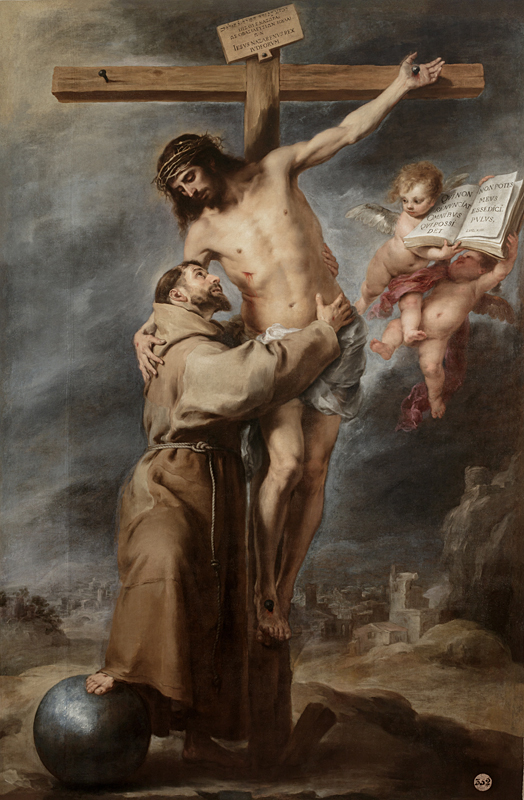
Bartolomé Esteban Murillo, 1617–1682. Saint Francis embracing the Crucified Christ, 1668-9. Oil on canvas, 291 x 191 cm. © Museo de Bellas Artes de Sevilla.
There is some very thoughtful placement of works in this display. The Gormley is positioned so that it welcomes the visitor to the exhibition, while lining up the stigmatised Francis with the stigmatised Christ in the spectacular Saint Francis Embracing the Crucified Christ (1668-69) by Bartolomé Esteban Murillo. What better way to herald Francis as alter Christus? In fact – whether by chance or by design, I do not know – the seven galleries are laid out in the shape of a cross. The other line of vision has Saint Francis and Eight Stories from his Life (c1250-60) by the Tuscan artist known as the Master of the Cross, at one end, in which the central figure of Francis, standing with a halo, Bible and raised hand, faces the tree trunk of Giuseppe Penone’s Albero Porta – Cedro (Door Tree – Cedar) (2012), carved hollow with an upright core intact, forming a “miniature tree” within a tree, lit up, and with branches and twigs of its own.
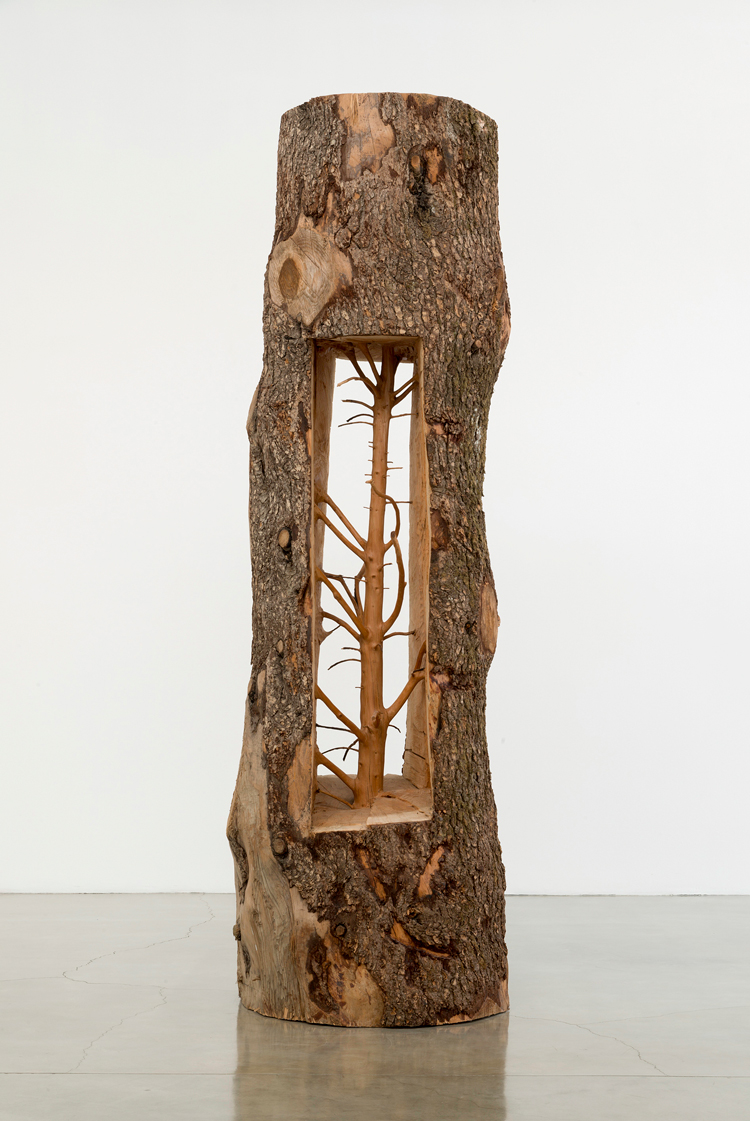
Giuseppe Penone. Door Tree-Cedar, 2012. Cedar wood, 317.5 x 101.6 x 101.6 cm. Gagosian & Marian Goodman Gallery. © Giuseppe Penone / photo © Josh White: JWPictures.com. Courtesy Gagosian.
Would it be taking the metaphor too far to suggest that if the trunk is taken to represent Jesus – strong and steady, a symbol of longevity, then the trunk within this trunk could represent Francis – the new, reborn alter Christus, with the twigs spreading and growing and reaching out to others, like his teachings? Like Gormley, Penone feels his life and work have been influenced by Francis and the Franciscan way of life. “It is possible,” he said in conversation with Gabriele Finaldi, the director of the National Gallery, “that the need for radicalness and simplification that I felt, especially in my early works, approaches the principles of poverty and rigour practised by Saint Francis.”3 The work also makes reference to the miracle said to have taken place in 1431, whereby the Virgin and Child appeared in a hollowed-out beech tree. This is depicted nearby in Descrizione del Sacro Monte della Vernia (1612), a book of prints on loan from the British Library, open to a spread illustrated with a friar, pointing upwards and showing said tree to a couple of pilgrims.
If the vertical line of the cross is sometimes taken to represent our relationship with God, and the horizontal our relationship with others, then this also fits with the curation here, since the stories of the saint’s life, and images of his reaching out, are displayed along the horizontal, while the vertical is bookended by representations – old and new, by Gormley and Murillo – of Francis’s and Christ’s stigmata respectively. The Murillo hangs, in fact, in a room entitled The Mystical Francis, where it is flanked by two paintings of the stigmata of Francis (Frans Pourbus the Younger’s Saint Francis Receiving the Stigmata, 1620, and El Greco’s Saint Francis Receiving the Stigmata, 1590-95) facing one another, and two paintings of Francis in ecstasy (Michelangelo Merisi da Caravaggio’s Saint Francis of Assisi in Ecstasy, c1595, and Francisco Ribalta’s The Ecstasy of Saint Francis: The Vision of the Musical Angel, c1620-25), also opposite one another. This is a wonderful hang, which allows for comparison of the works on the same subject, with a welcome bench placed against the empty wall, on which visitors can sit, contemplate and absorb, much as if in a chapel.
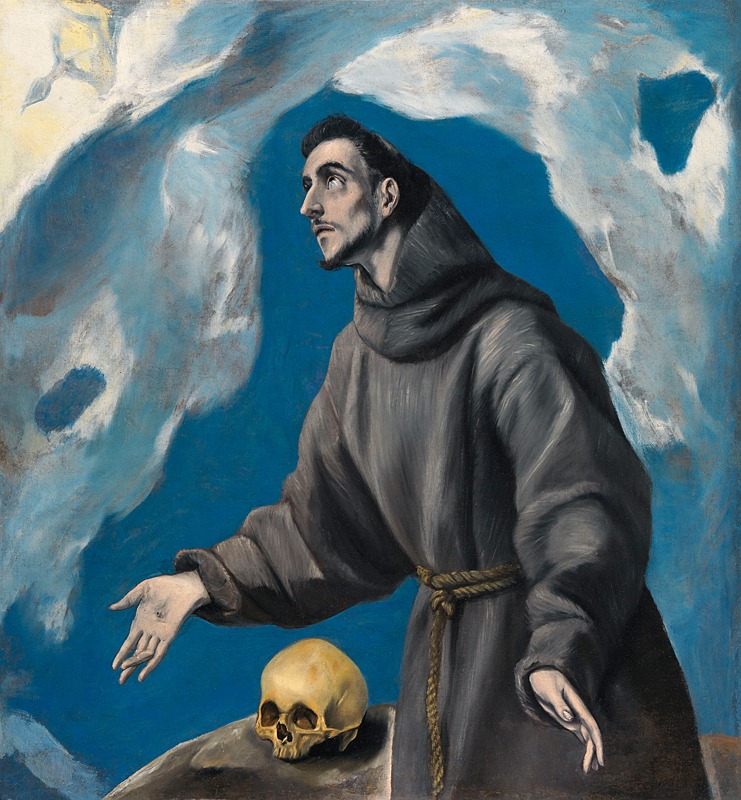
El Greco, 1541 – 1614. Saint Francis Receiving the Stigmata, 1590-95. Oil on canvas, 114 x 104 cm. © The National Gallery of Ireland, Dublin.
The Murillo work has to be my personal favourite in the exhibition. Francis, who, with his foot, is pushing away a globe (that is, renouncing all things worldly), is being embraced by the crucified Christ, who leans down from the cross, his right hand around Francis’s shoulders, level with Francis’s own, which reaches up around Jesus’s waist. The two hands are thus at the same height, mirroring their respective marks of the stigmata. Their right feet similarly mirror their marks. Two cherubim hold an open Gospel book, displaying, in Latin, the text of Luke 14:33: “Whoever of you does not forsake all that he has cannot be my disciple.” Murillo was another artist with a strong belief in Franciscan ideals, as epitomised by this verse, and he dedicated himself to their secular pursuit by becoming a lay member of the order in 1662 (shortly before making this work).
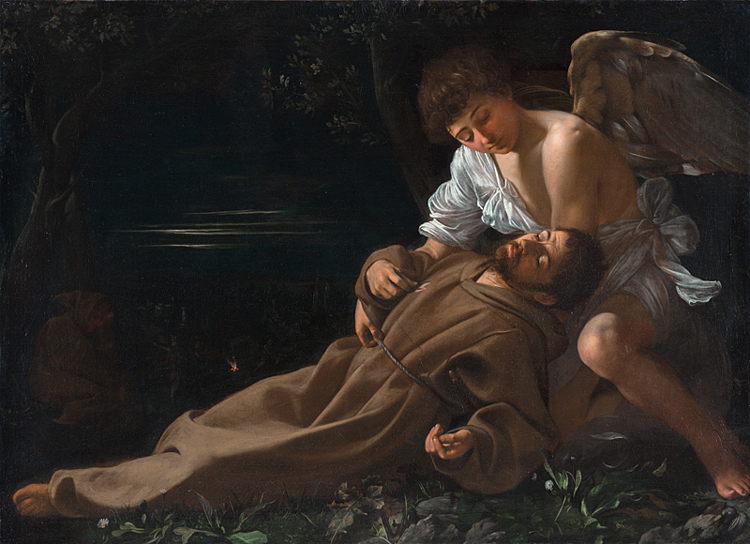
Michelangelo Merisi da Caravaggio, 1571–1610. Saint Francis of Assisi in Ecstasy, about 1595-96. Oil on canvas, 94 x 130 cm. Wadsworth Atheneum Museum of Art, Hartford, CT. The Ella Gallup Sumner and Mary Catlin Sumner Collection Fund. © Wadsworth Atheneum Museum of Art / photo: Allen Phillips.
Caravaggio’s painting of Francis in ecstasy is one of his earliest religious paintings. He is not known as the master of chiaroscuro for nothing, and the light cast down from out of the frame, at the top right-hand corner, cascades over the tip of the angel’s wing and down across his shoulder and knee, as he tenderly holds Francis in his blissful state. The folds of Francis’s habit are distinguished by the ray of light, as is a single daisy – a symbol of rebirth – by his foot.
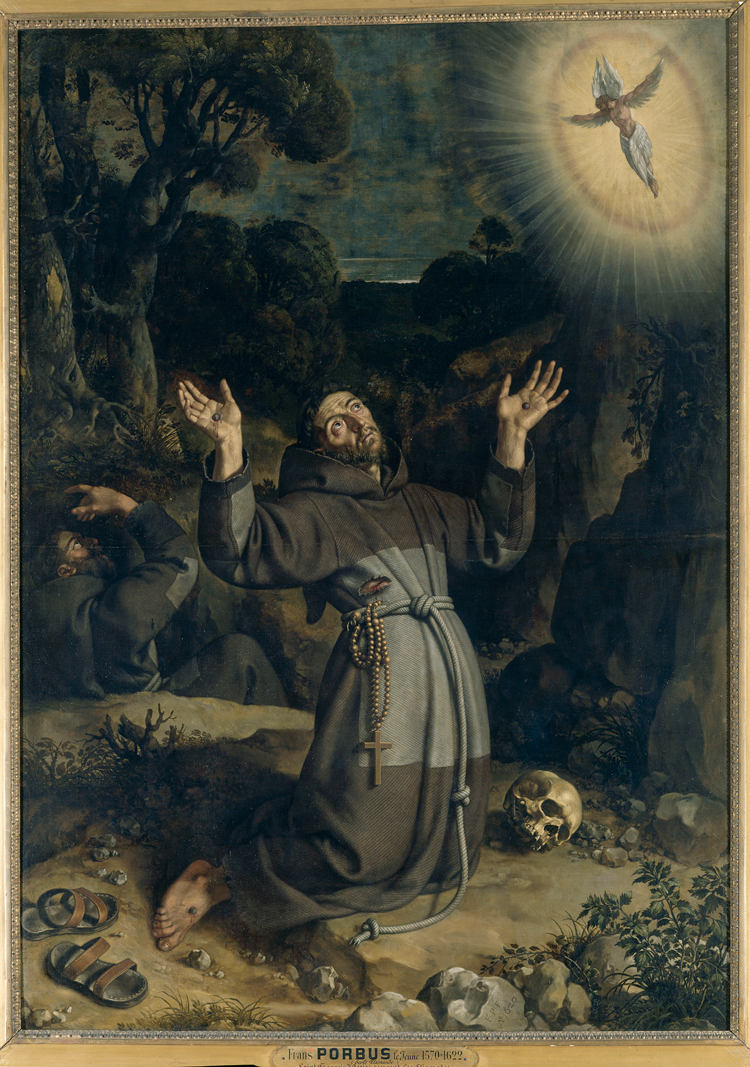
Frans Pourbus the Younger, 1569 – 1622. Saint Francis Receiving the Stigmata, 1620. Oil on canvas, 227 x 162 cm. Musée du Louvre, Paris. © RMN-Grand Palais (musée du Louvre) / Gérard Blot.
The light in Pourbus’s work is also superlative, with a seraph, in the form of a six-winged angel, enveloping the figure of Christ on the cross, surrounded by a blaze of glory, as Francis receives the stigmata. He has taken his sandals off before the vision, probably in imitation of Moses before he was visited by the divine presence in the burning bush. The rosary at his waist testifies to his devotion to the Virgin Mary, and the skull to the right recalls his frequent meditations on the transitory nature of human life and the ultimate vanity of all earthly things. While El Greco’s rendering of this miracle likewise incorporates a skull, it is much more closely focused on its protagonist, who, in this instance, is receiving the stigmata from a blaze of white light breaking through the clouds. This work is one of approximately 135 surviving paintings of Francis attributed to El Greco and his collaborators.
Another fantastic parallel drawn in the exhibition is between a habit – a relic believed to be one of only four remaining, worn by Francis, and borrowed from the Basilica of Santa Croce in Florence – and the arte povera artist Alberto Burri’s Sacco (Sack) (1953), not only materially akin to the Franciscan habit, but with a painted red circle, which might suggest the stigmata (others read it as making reference to the wounded of the war, but Burri hailed from the Franciscan heartland in Italy, and, as such, was yet another artist influenced by the saint, with the aesthetics of arte povera certainly reflecting the ethics of the Franciscan teachings).
Another artist whose ethos tallies with the Franciscan is the contemporary land artist Long. Not wanting to miss a trick, the National Gallery commissioned him to make a new work for the exhibition. An artist committed to experiencing the distinctive character of particular landscapes by living in them in a solitary manner, Long spent a week on Mount Subasio, overlooking Assisi, sleeping outdoors, to fully immerse himself. The outcome was A Walk for Saint Francis (2022), in which he evokes the Umbrian landscape through words and phrases (think “yellow light”, “distant bells”, “a mud hole” and “cracked earth”), laid out to form a circle, noted down while on an eight-day circular walk. Also on display is River Avon Mud Crescent (2011), in which he transforms mud, the most humble of materials, “into something spectacular and spiritually charged”.4 In Long’s own words: “It’s the gravitational pull of the moon that makes the tides, and it’s the big tides that make the mud. I make the top half of the image, and nature – gravity – makes the lower half.”5 This seems to distil the absolute quintessence of Franciscan ideals.
A brief mention must go to the small section of the exhibition dedicated to St Clare, one of Francis’s first followers, who went on to establish a sisterhood, the Poor Clares, and who is viewed as a model for the female Franciscan way of life. Of six lithographs, depicting scenes from the life of Francis, by the Australian artist Arthur Boyd (1965), two feature this “bride of Christ”. They derive from a series of 16, used to illustrate a reprint of the art historian TSR Boase’s Saint Francis of Assisi (1938, republished in 1968), and the works are displayed here alongside texts from this book. Plate X, which shows St Clare and Francis eating together, portrays the latter with a double face: one looking up at St Clare, who radiates light like the sun; the other looking down, through apparent flames, at the townspeople below, as they seek to extinguish the fire, unaware that this is no earthly light. My favourite work in this section, however, is another from the collection of the National Gallery: a delicate and sensitive fragment from Ambrogio Lorenzetti’s series of frescoes, A Group of Four Poor Clares (c1336-40). Its fractured edges and the soft gaze of the nuns renders the image reverential and serene.
The show concludes with a room of contemporary exhibits of different media, including posters for various films made about Francis, and Francis, Brother of the Universe, a Marvel comic from 1980, proclaiming the saint as “the first superhero”. The storyline remains remarkably faithful to his real-life biography. The final work, however, is another by Büttner – a series of nine, large-scale, white-on-black woodblock prints, entitled Beggars (2016). Part of her “iconography of poverty”, they further the artist’s exploration of impecuniosity and shame, and based on the German expressionist sculptor Ernst Barlach’s bronze Verhüllte Bettlerin (Veiled Beggar) (1919), there is certainly a sense of burgeoning volume to their hooded, habit-wearing-like forms.6 The wall text suggests these images of hardship and need could be read as a “call to action” for the visitor to show more empathy – and to perhaps live more according to Franciscan ideals – on leaving the exhibition. Certainly, faith in miracles aside, there is much that can be taken away from this brief introduction to a humble and peacekeeping man. As Joustra said, in an online event to accompany the exhibition: “The beauty of Francis is he has never stopped feeling modern.” He engages with nature and the environment; he engages with the poor and needy; he engages with people of other faiths. Above all, in each of these engagements, with what are fundamental issues for us all, Francis cultivates not only empathy, but a basic and far-reaching humanity. This may sound trivial, but it is something we could all do with practising out there in the world of 2023.
References
1. Saint Francis of Assisi, exhibition catalogue, National Gallery, London, 2023, page 61.
2. Saint Francis of Assisi, exhibition catalogue, National Gallery, London, 2023, page 116.
3. Giuseppe Penone in conversation with Gabriele Finaldi in 2021, cited in Saint Francis of Assisi, exhibition catalogue, National Gallery, London, 2023, page 110.
4. As described by Joost Joustra in Saint Francis of Assisi, exhibition catalogue, National Gallery, London, 2023, page 61.
5. Letter from Richard Long to Gabriele Finaldi, August 2022, cited in Saint Francis of Assisi, exhibition catalogue, National Gallery, London, 2023, page 66.
6. Interestingly, Barlach’s beggar is explicitly female (as indicated by the -in suffix in German), whereas, by choosing to only give an English title, Büttner’s beggars remain gender-neutral.